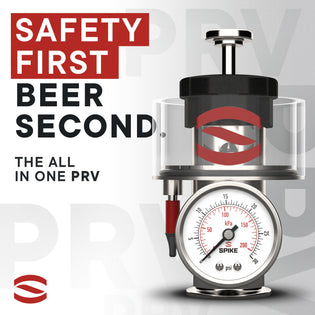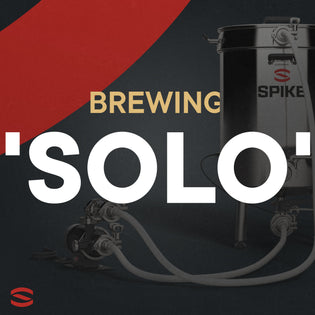By Matt Dailey
For many of us, homebrewing begins as this feeling of excitement. The idea that we can brew a beer for our buddies to enjoy and call our own is something we all strive for. It doesn’t take long before it grows into more than that. It becomes a passion. For me, brewing is something mankind has been doing for thousands of years, and I always wanted to be a part of that history.
I’m Matt Dailey, and I run Oil Creek Brewing Co. I started with a one-gallon kit fermenting in my closet, and now I write blog posts, recipes, and share insights and tips on Instagram and Facebook on a regular basis.
Many of us love a good IPA or a stout on a cold day. But after a hot day in the sun, we reach for a nice, cold, crisp refreshing lager. I mean, is there anything better?
Even though these two beer styles are constantly being used interchangeably, they really need (and deserve!) their own individual spotlight—because they are very different!
In this blog, I’ll be shining light on the differences between ales and lagers and how you can distinguish them from one another.
What Is The Key Difference Between A Lager And An Ale?
The key difference between ales and lagers is the yeast they’re brewed with. When it comes to these two styles of beer, yeast is the star of the show.
Speaking of yeast, let’s start with a few of the main ingredients of beer. Reminder that beer is made up of four main ingredients: water, grain, hops and yeast.
If you make a beer with 10lbs of 2 row, some chocolate malt, roasted malt, a handful of caramel malt and 25 IBUs of hops and pitch a vial of English ale yeast, the result is a porter ale.
“Beer is made up of four main ingredients: water, grain, hops and yeast.”
If you use those same malts and hops but pitch a vial of Czech Lager yeast, you’ll have a dark Czech lager. Similar ingredients, but worlds apart when it comes to flavor, mouthfeel and aroma.
So what makes them different? Once again…it comes down to yeast.
What Is An Ale?
Saccharomyces cerevisiae, also known as ale yeast, is the largest and oldest yeast variety known in the brewing world. There are literally hundreds of strains of this yeast. It ferments between 65°F and 95°F. You can use a different strain of this yeast to brew a Kölsch, IPA, stout, ESB, Hefeweizen or any other beer in the ale family.
Of course, each strain has its respective characteristic esters that make each ale unique. You may also hear this yeast called a top fermenting yeast.
What Is A Lager?
Saccharomyces pastorianus, also known as lager yeast, is a relatively newer yeast in the brewing world (150 years as opposed to thousands of years with ale yeast). There are far fewer strains of this yeast as well, since it hybridized itself apart from its ale counterpart much more recently. For the most part, it produces alcohol under much colder temperatures.
While it typically ferments between the upper 40s to 55°F, one strain, California lager, will ferment at 65°F. These beers are less fruity in ester production and ferment much slower than ales. You will also hear these called bottom fermenting yeasts.
How Does the Difference Impact The Brewing Process?
Yeast
Each variety is dependent on temperature. If you don’t have the ability to keep your fermenting beer between the upper 40s and under 60°F, you’ll be brewing mostly ales.

Alcohol Content
Lagers can withstand high abv, but you’ll need a lot more yeast to produce a higher abv beer. This means building a bigger starter. Typically, the higher abv beers you find will be ales. Not to say you won’t find an 8% Doppelbock (lager).
Temperature of Fermentation
As stated before, ales ferment between 65°F and 95°F. Some Kviek strains can even handle over 100°F! Lagers ferment in the upper 40s to 55°F.

Cold Storage
Each beer style benefits from being stored cold, but lagers require an extended storage time at cold temperatures. Being patient with your lager will pay off in the end—I promise.
Make yourself a good helles and drink a fresh pour, then drink it again 6-8 weeks after being lagered. You’ll then understand why being patient is one of the biggest aspects of lager brewing.
“Being patient is one of the biggest aspects of lager brewing.”
Hops Content
Neither ales or lagers are bound by hop content. From the biggest baddest ales out there, think Heady Topper or Pliny the Elder, there are bold lagers that match the hops, think Pivo or Mass Rising. Hoppy Pilsners or India Pale Lagers aren’t as common because lager beer is just now making headway on the craft beer radar.
Color
Both ales and lagers can be light in color or dark in color. Most folks probably prefer a pale lager after mowing the grass but may prefer a dark rich stout in the winter. Seek out the dark lagers this winter.
You’ll be pleasantly surprised.

Are Lagers Lighter than Ales?
The body in most lagers is generally lighter than that of its ale counterpart. In brewing, you’d probably mash in at a lower temp with a lot of lager styles. Even the darker ones. This leads to a drier and very crisp finish in most of your lager styles.
What Are the Most Popular Types Of Lagers and Ales?
We all know the most popular beer style in the United States is the tried and true IPA. No surprise there. But what is the most popular lager? Still, the American light lager reigns supreme. The craft beer industry is making a valiant effort to change the perception of American light lagers.
Just a couple years ago, you’d walk into a craft brewery and find a few IPA’s, a stout and maybe a sour. Now, you’re likely to find a lager or two on that tap list as well. It’ll be exciting to see what is to come for lager beer in the American craft beer scene.
Final Thoughts: The ‘You’ in What You Brew
Whether you’re brewing or drinking, there’s a beer for every occasion. Ales and lagers are separated by yeast. It all comes down to that. It depends on what you want to brew and have the capability to brew. If you do not have the ability to keep your beer cold during fermentation, you should avoid lagers as you’ll get off flavors.
Ales can provide for hundreds of interesting styles and combinations of ingredients. The main reason homebrewers tend to brew more ales comes down to that temperature control. If you’re looking to get into lager brewing, check out some temperature control options at your local homebrew store, online retailer or the TC-100 kit at Spike.
For more information, history lessons, tips, tricks and (most importantly!) to see what I’m brewing, follow along at Oil Creek Brewing Co.

Cheers!
Matt Dailey lives in Titusville, Pennsylvania and is a high school emotional support teacher. He has a bachelor's degree in history from Southern Illinois University and a Masters in Special Education from Slippery Rock University. He and his wife have 2 boys, ages 4 and 1. If he’s not spending time with his family or brewing and the weather allows, you can find him on the golf course.
FAQs
What is the difference between a lager and an ale?
Lagers are bottom-fermented beers made with bottom-fermenting yeast at cooler temperatures, while ales are top-fermented beers made with top-fermenting yeasts at warmer temperatures. Lagers tend to be lighter and crisper than ales, which are generally richer and fruitier.
What are some examples of a lager and an ale?
Examples of lager include Pilsner, Bock, and Marzen, while examples of ale include Pale Ale, India Pale Ale, and Wheat Beer.
What is the difference between a pilsner and a lager
Pilsners are a type of lager, but they are generally lighter in color and body than other lagers. They also have a more pronounced hop flavor, due to the increased use of hops during the brewing process.
is lager stronger than ale?
Is a lager stronger than an ale?
No, lagers typically have a lower alcohol content than ales.





